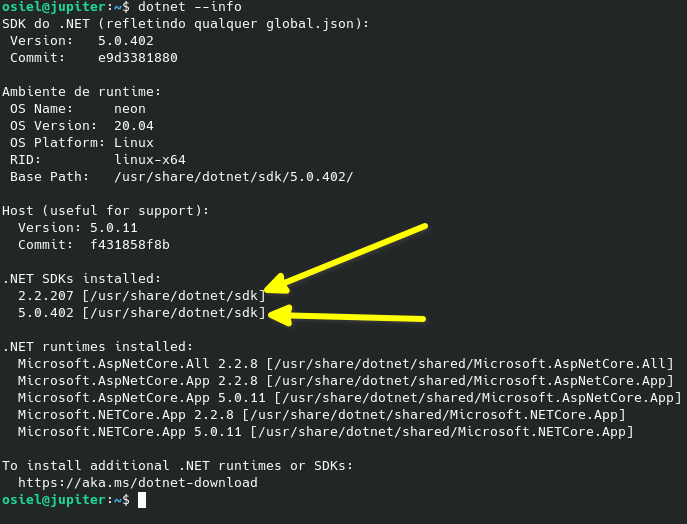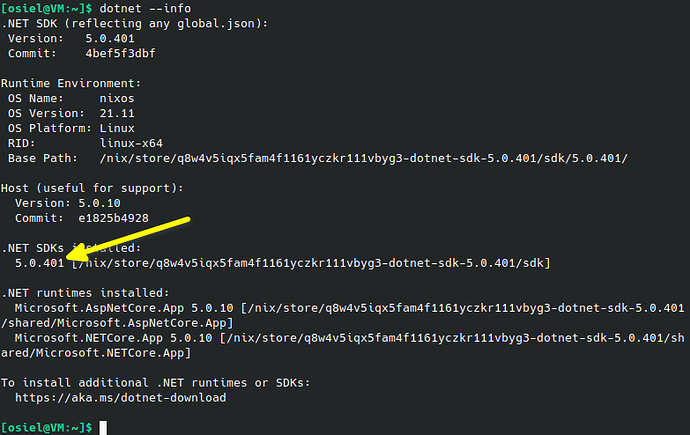Osiel
October 16, 2021, 12:16am
1
Hi guys!!!
So the company project compiles normally. I am trying to set up this kind of environment in NixOs
$ nix-env --preserve-installed -i dotnet-sdk-2.2.401 -f https://github.com/NixOS/nixpkgs/archive/596739026bbe0c693708119e5cd3e1b3aa88fd2d.tar.gz
$ nix-env --set-flag keep true dotnet-sdk-2.2.401
$ nix-env --preserve-installed -i dotnet-sdk
The result looks like the image below
I also tried something like (or vice versa)
$ nix-env --set-flag priority 5 dotnet-sdk
And it didn’t work, so I tried via nix-shell, creating the shell.nix file
{ pkgs ? import (fetchTarball “https://github.com/NixOS/nixpkgs/archive/596739026bbe0c693708119e5cd3e1b3aa88fd2d.tar.gz ”) {} }
And then I call the rider inside my nix-shell and I still can’t compile the projects.
Thanks.
1 Like
Osiel
October 16, 2021, 10:05am
3
Right, I created the example shell.nix file containing the link and it is indeed what I need
with import {};
mkShell {
But it is still not clear how I can use the dotnet-sdk_2_2 version as it has been removed and I only found the 19.09 version specifically here
“https://github.com/NixOS/nixpkgs/archive/596739026bbe0c693708119e5cd3e1b3aa88fd2d.tar.gz”
Sorry if it seems obvious how to do it but I still don’t understand about version that is not in nixpkgs.
Thank you very much for your help
dotnetCorePackages.sdk_2_2 exists in unstable and 21.05, you want:
with import {};
mkShell {
name = “dotnet-env”;
packages = [
(with dotnetCorePackages; combinePackages [
sdk_5_0
sdk_2_2
sdk_2_1
])
];
}
Osiel
October 17, 2021, 7:10pm
5
Well!!!
Here is my file as per your guidance
And this is the output when I run the file
So I changed it to
And I got this output, could you tell me where I am going wrong
Osiel
October 19, 2021, 7:04pm
6
With the show-trace command I got this answer could you give me some direction
I haven’t used dotnet since my last job. I think the correct course of action would be to create an overlay which adds it back.
IIRC, this should only be a blocker if you need sdk_2_2 to build a the package purely with nix. If you just need a dev environment, then the newer sdks should be able to retrieve in a way that’s compatible with nix (e.g. relative to home, not nix store binary).
Osiel
October 19, 2021, 7:32pm
8
I even tried to use 3.1 instead of 2.2 or 2.1 but the company’s project does not compile. I really need the 2.2 version.
About your suggestions could you give me more details on how to do.
Here’s some documentation on overlays, and how to apply them: Overlays - NixOS Wiki
in your case, you want something like:
prev: final: {
dotnetCorePackages = prev.dotnetCorePackages // {
sdk_2_2 = sdk_2_1.overrideAttrs (oldAttrs: {
src = oldAttrs.overrideAttrs (oldSrcAttrs: {
sha256 = "...";
url = "https://dotnetcli.azureedge.net/dotnet/Sdk/2.....-linux-x64.tar.gz";
});
});
};
}
That should be roughly enough, I just wrote this by hand, so I probably made some typos.
Of course, the best fix would be to not use an EOL sdk.
idjo
June 23, 2024, 4:05pm
10
Hi there, i manage to achieve this by using this shell.nix
let
pkgs = (import (builtins.fetchTarball "https://github.com/NixOS/nixpkgs/archive/0f87b32eb18e4fe3d19aa40176abbb996354ca88.tar.gz") { });
in
pkgs.mkShell {
buildInputs = [
pkgs.dotnet-sdk_3
];
}
this is the result:
hope it helps @Osiel








